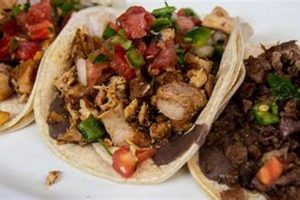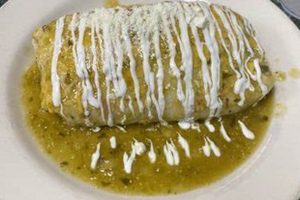The pairing of fermented grape beverages with the diverse flavors of regional Mexican cuisine presents a unique challenge and opportunity for culinary enthusiasts. The complex interplay of spices, acidity, and richness in many Mexican dishes necessitates a careful selection process to achieve a harmonious balance on the palate. For example, a rich mole poblano demands a wine that can stand up to its intensity without being overwhelmed, while a lighter ceviche requires a crisp, refreshing counterpart.
The successful integration of wine with Mexican food enhances the dining experience by complementing and contrasting specific flavor profiles. Historically, beverages like beer and tequila have been more commonly associated with Mexican cuisine. However, the increasing sophistication of both the wine industry and culinary arts has led to a broader exploration of vinicultural pairings. The benefits extend beyond mere flavor; appropriate pairings can elevate the perception of both the food and the drink, creating a memorable and enjoyable occasion.
Consequently, subsequent sections will delve into specific grape varietals and styles that pair particularly well with different categories of Mexican dishes. Considerations will be given to regional variations, spice levels, and common ingredients to provide a practical guide for selecting the ideal wine accompaniment.
Wine Pairing Tips for Mexican Cuisine
Achieving optimal flavor harmony requires careful consideration of the distinct characteristics of both the wine and the Mexican dish. The following tips offer guidance for successful pairings.
Tip 1: Consider the Spice Level: Avoid high-tannin red wines with very spicy dishes. The interaction between tannins and capsaicin can create an unpleasant, metallic taste. Opt for lower-tannin reds, off-dry whites, or sparkling wines instead.
Tip 2: Match Acidity with Acidity: Dishes with high acidity, such as ceviche or those using lime juice, require wines with equally high acidity. Sauvignon Blanc or Albario are excellent choices.
Tip 3: Pair Richness with Richness: Hearty dishes like mole or enchiladas benefit from wines with a comparable body. Consider a medium-bodied red with earthy notes, like Pinot Noir or a lighter-style Merlot.
Tip 4: Off-Dry Wines for Sweetness: Dishes with a touch of sweetness, such as those with fruit salsas, pair well with off-dry Riesling or Gewrztraminer. The slight sweetness in the wine complements the sweetness in the dish.
Tip 5: Ros for Versatility: Ros wines offer a versatile option for a wide range of Mexican dishes. Their balanced acidity and fruit-forward character make them a good choice when multiple dishes with varying flavor profiles are being served.
Tip 6: Sparkling Wines as Palate Cleansers: Sparkling wines, particularly those with a dry finish, can act as palate cleansers between courses, refreshing the palate and preparing it for the next flavor experience. Consider a dry Cava or Prosecco.
Tip 7: Consider Regional Pairings: Explore wines from regions with similar culinary traditions. For example, Spanish wines often pair well with Mexican cuisine due to shared cultural influences and flavor profiles.
By employing these tips, individuals can enhance their dining experience and discover the nuanced interplay between the flavors of carefully selected wines and the vibrant tastes of Mexican cuisine. These guidelines offer a starting point for exploration and experimentation.
The subsequent article segments will provide deeper analysis into specific wine varietals and their ideal Mexican food pairings.
1. Spice Level
The intensity of chili peppers and other spices within Mexican cuisine significantly dictates suitable wine pairings. Capsaicin, the active compound in chili peppers, creates a sensation of heat on the palate. This sensation is exacerbated by tannins present in many red wines, often resulting in an unpleasant metallic taste. Consequently, selecting a wine with lower tannins is crucial to mitigate this adverse reaction. A high-tannin Cabernet Sauvignon, for instance, would generally be a poor choice with spicy tacos al pastor. Instead, a lighter-bodied Pinot Noir or a white wine with residual sugar may provide a more harmonious pairing.
The level of spiciness is not a monolithic factor; it varies considerably across regional Mexican dishes. Dishes from Oaxaca often feature complex mole sauces with multiple types of chilies, while dishes from the Yucatan peninsula may emphasize habanero peppers’ intense heat. This variation necessitates careful consideration of the specific dish’s spice profile. Furthermore, individual tolerance to spice differs, so understanding the target audience’s preference is also relevant when making wine recommendations. A milder poblano pepper stuffed with cheese might pair acceptably with a lighter-bodied red, whereas a fiery salsa macha would demand a wine that actively cools and balances the palate.
In summary, the spice level is a critical determinant when selecting wine to accompany Mexican food. The goal is to avoid wines that amplify the heat sensation negatively, opting instead for those that offer a contrasting or complementary effect. Lower-tannin reds, off-dry whites, and even certain sparkling wines often provide a more palatable and enjoyable experience alongside spicy Mexican dishes. This understanding is fundamental to achieving a successful and balanced culinary pairing.
2. Acidity Balance
Acidity balance is a paramount consideration when selecting wine for Mexican cuisine, primarily due to the frequent presence of acidic elements within the dishes themselves. Ingredients such as lime juice, vinegar, and tomatillos contribute significantly to the overall flavor profile, necessitating a wine with sufficient acidity to complement, rather than be overwhelmed by, these components. The effectiveness of the wine pairing hinges on its capacity to harmonize with, or even elevate, the existing acidity in the food. Failure to achieve this balance can result in a wine that tastes flat or muted, diminishing the dining experience. A dish like ceviche, heavily reliant on lime juice, provides a compelling example. A low-acid wine will simply disappear against the backdrop of the dish’s inherent tartness, whereas a high-acid wine, such as a Sauvignon Blanc, will cut through the richness of the fish and cleanse the palate between bites.
The role of acidity extends beyond mere compatibility; it also serves to enhance other flavor components. A well-balanced acidity can accentuate the spiciness of chili peppers, the herbaceousness of cilantro, and the savory notes of grilled meats. Conversely, insufficient acidity can render these flavors dull and indistinct. In the context of tacos al pastor, the pineapple’s sweetness and the pork’s richness are often balanced by a squeeze of lime. A crisp, dry Ros, with its refreshing acidity, can mirror this balancing act on the palate, creating a cohesive and flavorful experience. The practical application of this understanding lies in the ability to predict and manipulate the overall flavor profile of a meal through strategic wine selection. By considering the specific ingredients and preparation methods used in Mexican dishes, individuals can identify wines that will effectively complement the inherent acidity and create a more balanced and enjoyable dining experience.
In conclusion, acidity balance is not merely a desirable attribute but a fundamental requirement for successful wine pairings with Mexican cuisine. The presence of acidic ingredients in many dishes necessitates a wine with sufficient acidity to avoid being overpowered and to enhance other flavor components. An informed approach to acidity balance allows for a more nuanced and sophisticated appreciation of both the wine and the food, ultimately leading to a more satisfying culinary experience. Challenges arise in discerning subtle acidity variations within both the wine and the food, requiring a refined palate and a thorough understanding of flavor interactions. This understanding contributes to the broader appreciation of viniculture as a component of Mexican food pairing.
3. Richness Matching
The principle of richness matching, an aspect of pairing wine with Mexican food, involves selecting wines with body and intensity congruent with the dish’s weight and texture. This strategy aims to prevent one element from overwhelming the other, creating a balanced and harmonious sensory experience.
- Fat Content and Wine Body
The fat content of a dish significantly influences the perceived richness. Rich dishes, such as those with cheese or cream-based sauces, require wines with sufficient body to cut through the fat and cleanse the palate. A full-bodied Chardonnay or a medium-bodied red wine like Merlot can effectively complement these heavier dishes. Conversely, pairing a delicate, light-bodied wine with a fatty dish may result in the wine being lost amidst the richness of the food.
- Sauce Intensity and Wine Structure
Mexican sauces, ranging from light salsas to complex moles, contribute significantly to the dish’s overall richness. Intensely flavored sauces require wines with corresponding structure and complexity. A mole poblano, with its blend of chilies, chocolate, and spices, calls for a wine capable of standing up to its multifaceted profile. A lighter-bodied red wine with earthy notes or a robust Ros may be suitable. Simpler sauces, like a fresh tomato salsa, pair well with lighter, crisper white wines, such as Sauvignon Blanc or Pinot Grigio.
- Protein Weight and Tannin Levels
The type of protein used in a Mexican dish also affects the perception of richness. Grilled meats, like carne asada, possess inherent richness and can benefit from wines with moderate tannin levels. The tannins in the wine interact with the proteins, creating a more balanced flavor profile. However, excessively tannic wines may clash with the spices and seasonings often used in Mexican meat dishes. Therefore, selecting a wine with well-integrated tannins is crucial.
- Preparation Method and Wine Style
The preparation method employed for a Mexican dish can further influence the perceived richness. Dishes that are fried or braised tend to be richer than those that are grilled or steamed. Fried dishes, such as chimichangas, may benefit from wines with high acidity to cut through the grease. Braised dishes, like carnitas, require wines with sufficient body and complexity to match the depth of flavor developed during the long cooking process. A richer style of Ros or a lighter red wine can provide the necessary balance.
Ultimately, applying richness matching principles enhances the enjoyment of Mexican cuisine by creating a symbiotic relationship between the dish and the wine. By carefully considering the factors contributing to a dish’s richness, individuals can select wines that elevate the overall culinary experience.
4. Sweetness contrast
The principle of sweetness contrast, when applied to pairing wine with Mexican food, addresses the interaction between sugary elements in a dish and the wine’s sugar level. Many Mexican dishes incorporate sweetness through ingredients like fruit, caramelized onions, or added sugar in sauces. The goal is to select a wine whose sweetness level either complements or contrasts the dish’s sweetness, thereby enhancing overall flavor balance. For example, dishes featuring mole negro, known for its subtle sweetness derived from chocolate and dried fruit, often benefit from wines with a touch of residual sugar, like off-dry Riesling or Gewrztraminer. The wine’s slight sweetness underscores the mole’s nuanced flavors, preventing it from tasting overly bitter or unbalanced. A wine that is too dry may taste austere in comparison, lacking the capacity to harmonize with the dish’s inherent sweetness.
Conversely, a contrast in sweetness can be strategically employed. Consider dishes incorporating fruit salsas, like mango salsa served with grilled fish. In these instances, a dry wine with bright acidity can provide a refreshing counterpoint to the salsa’s sweetness. A crisp Sauvignon Blanc, for example, can cleanse the palate between bites, preventing the sweetness from becoming cloying. The wine’s acidity cuts through the sugar, ensuring that the dish remains vibrant and refreshing. However, the level of sweetness in the dish and the wine must be carefully considered. An intensely sweet dessert wine paired with a mildly sweet salsa might create an imbalance, with the wine overwhelming the delicate flavors of the food. Similarly, a bone-dry wine paired with an excessively sweet dessert could taste unpleasantly acidic. Therefore, a nuanced understanding of the specific sweetness levels in both the wine and the food is essential.
In summation, the successful application of sweetness contrast hinges on a careful evaluation of the dish’s sweetness profile and the selection of a wine with a compatible level of sweetness or acidity. The objective is to create a harmonious balance that enhances the dining experience. Challenges lie in accurately assessing the sweetness levels and predicting their interactions. By thoughtfully applying this principle, individuals can unlock new flavor dimensions and elevate the pairing of wine with Mexican cuisine. The interplay of sweetness and acidity, a subtle yet powerful aspect of flavor interaction, plays a crucial role in overall food pairing strategies, emphasizing the significance of careful selection.
5. Regional affinity
The concept of regional affinity plays a crucial role in the successful pairing of wine with Mexican food. This principle posits that wines from regions with culinary traditions similar to, or historically linked with, Mexico often provide complementary pairings. The underlying rationale stems from shared agricultural practices, climatic conditions, and cultural influences that shape both the cuisine and the viniculture of these regions. The result is a natural synergy between the flavors and textures, creating a cohesive and harmonious dining experience. For example, the Baja California region of Mexico, known for its seafood-centric cuisine, shares a Mediterranean climate with parts of Spain and Italy. Consequently, crisp, dry white wines from these European regions, such as Albario from Spain or Vermentino from Italy, frequently pair well with Baja-style fish tacos or ceviche. The bright acidity and citrus notes of these wines complement the freshness of the seafood and the tang of the lime-based marinades, creating a refreshing and balanced combination.
Conversely, regions with vastly different culinary traditions may yield less successful pairings. A heavy, oaky California Chardonnay, for instance, might clash with the vibrant spices and acidity characteristic of many central Mexican dishes. The wine’s buttery texture and dominant oak flavors could overwhelm the more delicate flavors of the food, resulting in a muddled and unbalanced experience. However, certain wines from regions with distinct culinary profiles can still find successful pairings if carefully selected. For example, a light-bodied Beaujolais from France, with its bright acidity and fruity notes, can provide a refreshing contrast to richer, spicier dishes like carnitas. The key lies in understanding the specific flavor profiles of both the wine and the food and identifying pairings that offer either complementarity or a deliberate and harmonious contrast.
In conclusion, understanding regional affinity provides a valuable framework for selecting wines to accompany Mexican food. While not a rigid rule, it offers a useful starting point for exploration and experimentation. The concept acknowledges the influence of shared culinary and agricultural heritage on flavor profiles, suggesting that wines from geographically or culturally related regions often provide naturally harmonious pairings. The challenge lies in applying this principle with nuance, considering the specific characteristics of individual dishes and wines. The practical significance of this approach is its potential to enhance the dining experience by creating more balanced, flavorful, and culturally resonant combinations.
Frequently Asked Questions About Wine Pairing with Mexican Cuisine
The following questions address common inquiries regarding the selection of suitable wines for consumption with Mexican food, aiming to provide clarity on established pairing principles.
Question 1: Are red wines generally unsuitable for spicy Mexican dishes?
High-tannin red wines can exacerbate the sensation of heat from chili peppers, potentially creating an unpleasant metallic taste. Lower-tannin reds, or wines with a touch of residual sugar, often provide a more harmonious pairing. The choice depends heavily on the specific dish and its level of spiciness.
Question 2: Is there a universal wine pairing for all types of tacos?
Given the diversity of taco fillings and preparations, a single, universally applicable wine pairing is unlikely. Lighter tacos, such as fish tacos, benefit from crisp white wines. Richer, meat-filled tacos may pair better with lighter-bodied red wines or robust Ros.
Question 3: Does the acidity of a wine influence its compatibility with Mexican food?
Acidity plays a crucial role. Many Mexican dishes incorporate acidic ingredients like lime juice or tomatillos. Wines with sufficient acidity are necessary to avoid being overwhelmed by the food’s inherent tartness. High-acid wines often pair well with dishes like ceviche.
Question 4: Can sweet wines ever be paired with Mexican cuisine, or are they always a poor choice?
Sweet wines can be effective pairings, particularly with dishes that incorporate a touch of sweetness. Off-dry Riesling or Gewrztraminer can complement dishes with fruit salsas or those featuring mole sauces with chocolate notes. The key is to balance the sweetness levels appropriately.
Question 5: Is it necessary to consider the regional origins of both the wine and the food when pairing?
Regional affinity can be a helpful guideline. Wines from regions with similar culinary traditions often provide complementary pairings. For example, Spanish wines may pair well with certain Mexican dishes due to shared historical and agricultural influences. However, this is not a rigid rule, and exceptions exist.
Question 6: What is the best way to learn more about wine pairing with Mexican food?
Experimentation and personal taste are valuable learning tools. Exploring different wine varietals and styles alongside various Mexican dishes allows for the development of a refined palate and an understanding of flavor interactions. Consulting with sommeliers or wine experts can also provide valuable insights.
The preceding points underscore the importance of careful consideration and experimentation when pairing wine with Mexican food. There are general guidelines to assist you with wine selection to enhance your overall tasting experience.
The next section will discuss practical applications of these principles, offering specific wine recommendations for a range of popular Mexican dishes.
Concluding Remarks on Wine to Drink with Mexican Food
This exposition has explored the nuances of selecting “wine to drink with mexican food,” emphasizing critical factors such as spice level, acidity balance, richness matching, and regional affinity. Optimal pairings require a nuanced understanding of flavor interactions and a willingness to experiment beyond conventional assumptions. The complex interplay of ingredients in Mexican cuisine necessitates a deliberate approach to wine selection to achieve a balanced and enjoyable dining experience.
The informed application of these principles will enhance the appreciation of both the wine and the food, elevating the culinary experience. Continued exploration and refinement of these pairings promises further discovery and a deeper understanding of the harmonious relationship between viniculture and Mexican gastronomy. This information may be applied to the world.







